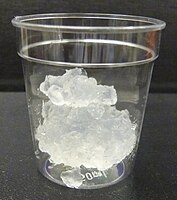
Photo from wikipedia
Nanocellulose hydrogels are highly hydrated porous cellulosic soft materials with good mechanical properties. These cellulose-based gels can be produced from bacterial or plant cellulose nanofibrils, which are hydrophilic, renewable, biodegradable… Click to show full abstract
Nanocellulose hydrogels are highly hydrated porous cellulosic soft materials with good mechanical properties. These cellulose-based gels can be produced from bacterial or plant cellulose nanofibrils, which are hydrophilic, renewable, biodegradable and biocompatible. Nanocellulose, whether fibrils (CNF), crystals (CNC) or bacterial (BNC), has a high aspect ratio and surface area, and can be chemically modified with functional groups or by grafting biomolecules. Cellulose functionalization provides enhanced physical and chemical properties and control of biological interactions, tailoring its hydrogels for specific applications. Here, we critically review nanocellulose hydrogels for biomedical applications. Nanocellulose hydrogels have been demonstrated for 3D cell culture, mimicking the extracellular matrix (ECM) properties with low cytotoxicity. For wound dressing and cartilage repair, nanocellulose gels promote cell regeneration while providing the required mechanical properties for tissue engineering scaffolds. The encapsulation of therapeutics within nanocellulose allows the targeted delivery of drugs. Currently, cellulose crosslinking to peptides and proteins enables a new generation of low cost and renewable smart materials used in diagnostics. Last, the organized mesh of fibres contained in hydrogels drives applications in separation of biomolecules and cells. Nanocellulose hydrogels have emerged as a highly engineerable platform for multiple biomedical applications, providing renewable and performant solutions to life sciences.
Journal Title: Advances in colloid and interface science
Year Published: 2019
Link to full text (if available)
Share on Social Media: Sign Up to like & get
recommendations!